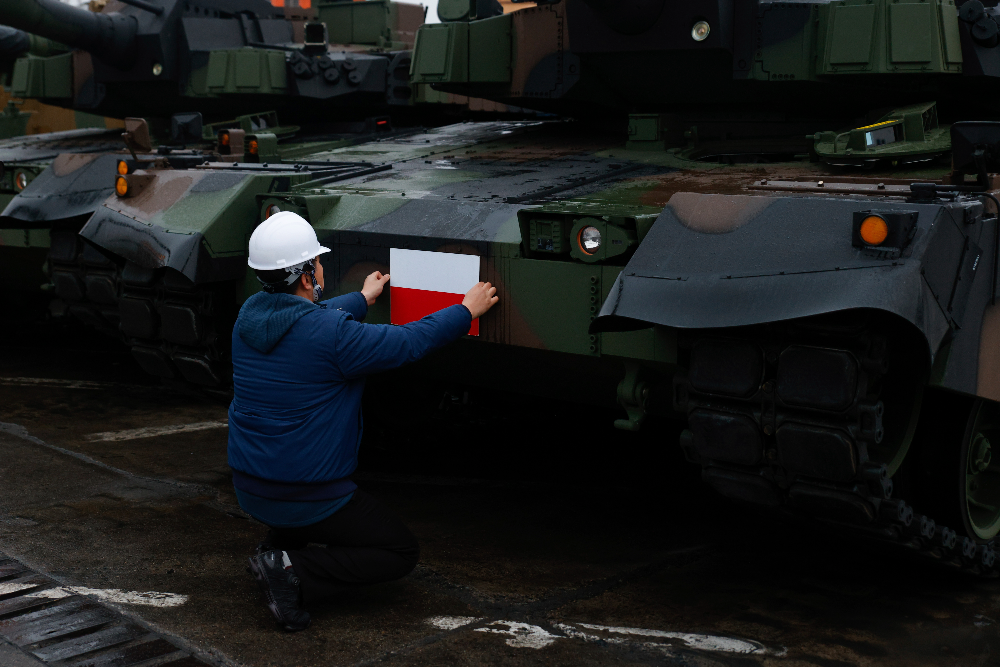
- #Europe
- #Security & Defense
- #South Korea

Key Takeaways:
- Russia's invasion of Ukraine created an urgent demand for military rearmament in Europe that its own industrial base could not supply quickly enough.
- South Korea has become a key arms supplier, especially to Poland, by offering NATO-compatible systems (like tanks and howitzers) faster, cheaper, and with better industrial cooperation than competitors.
- While the partnership is growing, its long-term future is limited, as European nations aim to build their own industrial self-reliance and South Korea struggles to enter the protected, high-end markets of Western Europe.
As Russia’s aggression continues to unsettle Eastern and Northern Europe, few countries can empathise more than South Korea. Confronting its own nuclear-armed neighbour across one of the world’s most militarised borders, Seoul has long relied on a dual strategy: reinforcing deterrence at home while cultivating strategic partners abroad. The United States remains its most comprehensive ally, with deep military, diplomatic, and economic ties, and relations with Japan are improving despite a complicated historical legacy. Yet, in recent years, South Korea’s most dynamic partnerships have emerged not in Asia or across the Pacific, but in Europe—most notably with Poland and several other EU member states.
The roots of this evolving relationship trace back to the early 1990s, when South Korea’s democratisation coincided with Europe’s deepening integration under the 1993 Maastricht Treaty. The partnership initially focused on trade, formalised by the 2001 EU–ROK Framework Agreement, and later broadened into a strategic partnership culminating in the EU–ROK Security and Defence Partnership signed in November 2024. This most recent phase coincided with a marked deterioration of the global security environment: Europe faced the continued Russian invasion of Ukraine, while South Korea experienced pressure from the United States on the economic and security fronts while confronting the unabated nuclearization of North Korea. In this shifting landscape, both Europe and South Korea have sought to diversify partnerships and strengthen resilience through pragmatic cooperation.
Russia’s full-scale invasion of Ukraine in 2022 forced European leaders to confront a longstanding dilemma. Supporting Kyiv required financial and material resources that many states no longer possessed after decades of constrained defence spending. In response, the EU adopted the ReArm Europe plan, while individual member states such as Germany or France have announced unprecedented budgetary increases. Yet, even as funding has improved, European governments have quickly realised that their industrial base cannot deliver new systems rapidly. Limited production capacity, supply-chain fragility, and shortages of skilled labour hamper their ability to respond to urgent operational needs.
This urgent rearmament effort has opened the door to alternative suppliers. While the United States remains Europe’s primary defence partner, South Korea has emerged as a credible and agile alternative. Its most significant entry point has been Poland, which since 2022 has concluded a series of large-scale contracts for K2 Black Panther tanks, K9 Thunder howitzers, K239 Chunmoo rocket launchers, and FA-50 light aircraft. These contracts have been accompanied by industrial cooperation agreements, including local production and maintenance facilities for the K2 and K9 systems, establishing Poland as a regional hub for South Korean defence manufacturing. The K9, in particular, has become a bestseller in Europe, with sales extending to Romania, Estonia, Finland, and Norway.
Several factors have contributed to the recent surge in South Korean defence exports to Europe. Chief among them is the urgency to fill critical capability gaps. Poland has been at the forefront of Europe’s defence spending surge since the invasion of Ukraine, increasing its defence budget from 2.7 per cent of GDP in 2022 to 4.7 per cent in 2025, the highest ratio within NATO. Besides advocating for an uncompromising deterrence strategy against Russia, Warsaw has pursued self-reliance in defence production. However, its domestic industrial capacity has been insufficient to meet short-term operational needs, compelling it to seek foreign suppliers capable of rapid delivery and willing to localise production.
South Korea was already a well-established collaborator for Poland before 2022. Polish defence contractor Huta Stalowa Wola began manufacturing the Krab self-propelled howitzer in 2014 using a licensed K9 chassis from Samsung Techwin. When Poland decided to accelerate its military modernisation, Seoul emerged as a logical supplier for two reasons: its ability to deliver quickly and its openness to long-term coproduction arrangements.
The speed of South Korean deliveries has been particularly striking. The first ten K2 tanks were delivered to Poland in December 2022, only a few months after the signing of the contract. By December 2024, Poland had received 84 of the 120 units ordered. By comparison, European manufacturer KNDS planned to deliver 54 Leopard 2 tanks to Norway over three to five years. Similarly, Korea Aerospace Industries delivered twelve FA-50 aircraft to Poland by November 2023, within a year of contract signature, and aims to deliver 36 more FA-50PL variants co-developed with Polish industry by 2026.
South Korea’s success rests not only on delivery speed but also on design compatibility and affordability. Seoul has systematically adopted NATO standards for its systems: South Korean artillery uses 155-millimeter ammunition, and the government has streamlined airworthiness certification with NATO countries. This interoperability has also facilitated exports to the United States, as illustrated by the leasing of 300,000 rounds of Korean ammunition to support Ukraine. Furthermore, South Korean systems tend to be significantly cheaper than their American or European equivalents, enhancing their competitiveness in cost-sensitive procurement markets.
South Korean defence manufacturers also offer generous industrial participation terms, including local assembly and technology transfer particularly attractive to countries like Poland seeking to expand their own industrial base. This flexible approach contrasts with the more rigid export models of some European producers and has contributed to Seoul’s growing credibility as a strategic supplier rather than a mere stopgap source of equipment.
Deepening defence relations with South Korea also offers advantages from a political perspective. Bilateral or minilateral initiatives within NATO, such as the Franco–British Lancaster House Treaties or the Visegrád Group among Central European states, have occasionally raised concerns about diluting alliance cohesion. By contrast, cooperation with a geographically distant, non-NATO partner like South Korea carries little risk of intra-alliance competition. It also reinforces transregional cooperation among democratic states, aligning with broader European efforts to diversify strategic partnerships beyond the transatlantic sphere.
In the medium term, Europe–South Korea defence cooperation is likely to continue expanding. Both sides share complementary objectives: South Korea seeks to consolidate its industrial base through economies of scale and export diversification, while European states require reliable suppliers to meet their rearmament goals. Nevertheless, this growing relationship faces structural limitations. South Korea’s own defence industry is not immune to long-term challenges such as a shrinking skilled workforce and intensifying competition from other emerging producers, including China and Turkey. Moreover, Poland’s explicit goal is to strengthen domestic production capacity to achieve greater autonomy, which could eventually reduce reliance on Korean suppliers.
It is also notable that South Korea’s export successes in Europe have been largely confined to land systems, with limited traction in aerospace and no presence in the maritime domain. This pattern suggests that Korean defence products currently compete most effectively on cost-efficiency and production speed rather than on advanced technological sophistication. In more mature markets such as France, Germany, and the United Kingdom, where defence industries are considered strategic national assets, Korean firms are likely to encounter stronger political and institutional barriers to entry.
South Korea’s rise as a key defence supplier to Europe underscores how regional security dynamics are becoming increasingly interwoven in an era of systemic rivalry and rearmament. In the short to medium term, these complementarities are likely to sustain momentum, particularly in Eastern and Northern Europe. Over the longer horizon, however, the durability of this partnership will hinge on Seoul’s ability to evolve from a stopgap provider into a fully integrated strategic partner, contributing not just equipment but innovation, co-development, and long-term industrial partnership within Europe’s high-end defence ecosystem.

Nicolas Jouan is a defence and security analyst at RAND. Working primarily with RAND Europe, his research interests relate to defence spending, acquisition policy, European defence and regional geopolitics. He has contributed to policy research projects for high-profile clients, including the UK Ministry of Defence, the European Commission, the Australian Department of Defence, the U.S. Department of Defense and the U.S. Commission on Planning, Programming, Budgeting, and Execution Reform. Prior to joining RAND, Jouan worked for market research firms Euromonitor and GlobalData in London, where he specialised in the global defence industry. He also interned at the IHEDN in Paris and at the French Defence Mission in Hanoi, Vietnam. He holds an M.Litt. in international relations from the University of St. Andrews and a M.Res. in modern history from the University of Paris IV Sorbonne.